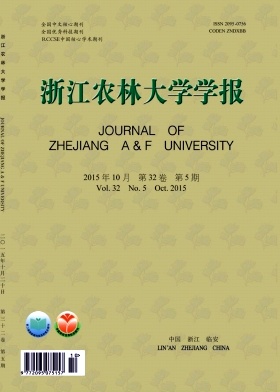| [1] |
YIN Zexin, ZHANG Lu, BAI Yifan.
Replacing peat with garden waste compost in Cosmos bipinnata cultivation
. Journal of Zhejiang A&F University,
2022, 39(5): 1045-1051.
doi: 10.11833/j.issn.2095-0756.20210829
|
| [2] |
TAN Qiyan, LI Suyan, SUN Xiangyang, HAO Huirong, LI Yinan, SUN Jingyu.
Study on light-weight substrate for roof greening with aquasorb and biosurfactant
. Journal of Zhejiang A&F University,
2021, 38(6): 1178-1186.
doi: 10.11833/j.issn.2095-0756.20200755
|
| [3] |
BAI Rongrong, GAO Yanming, LI Jianshe, WANG Lan, ZHANG Xue, LIU Junli.
Mineral element absorption, distribution, and growth of nutrient film technique cultured tomatoes with varying nutrient solution ratios
. Journal of Zhejiang A&F University,
2019, 36(6): 1217-1224.
doi: 10.11833/j.issn.2095-0756.2019.06.020
|
| [4] |
WANG Lin, LI Suyan, SUN Xiangyang, GONG Xiaoqiang, YU Kefei, CAI Linlin.
Mixing garden wastes and spent mushroom compost of different ratios for vermicomposting
. Journal of Zhejiang A&F University,
2019, 36(2): 326-334.
doi: 10.11833/j.issn.2095-0756.2019.02.014
|
| [5] |
XIAO Chaoqun, GUO Xiaoping, LIU Ling, LUO Chao, LI Ruoyu, LIU Guanhong.
Greening waste compost as a new substrate for green roofs
. Journal of Zhejiang A&F University,
2019, 36(3): 598-604.
doi: 10.11833/j.issn.2095-0756.2019.03.022
|
| [6] |
CAI Linlin, LI Suyan, GONG Xiaoqiang, SUN Xiangyang, ZHANG Jianwei, YU Xin, WEI Le.
Composting-vermicomposting of green waste processing spiked with cow dung
. Journal of Zhejiang A&F University,
2018, 35(2): 261-267.
doi: 10.11833/j.issn.2095-0756.2018.02.009
|
| [7] |
ZHU Mimi, ZHANG Chi, CHANG Ailing, DANG Wanyu, ZHOU Caihong, YU Dihu, WU Yingying, ZHANG Min.
Expression of microsporocyte meiosis with special genes RAD51 and MS1 in Citrus suavissima ‘Seedless’
. Journal of Zhejiang A&F University,
2016, 33(6): 921-927.
doi: 10.11833/j.issn.2095-0756.2016.06.001
|
| [8] |
YIN Cui, SUN Lixin, DONG Yan, CAO Zhen, ZHANG Yahong.
Growth, development, and quality of red globe grapes using root-zone soil heating in a plastic greenhouse
. Journal of Zhejiang A&F University,
2016, 33(6): 1092-1097.
doi: 10.11833/j.issn.2095-0756.2016.06.024
|
| [9] |
GONG Xiaoqiang, LI Suyan, LI Yan, SUN Xiangyang.
Compost and vermicompost from green wastes as substrates for vegetable seedlings cultivation
. Journal of Zhejiang A&F University,
2016, 33(2): 280-287.
doi: 10.11833/j.issn.2095-0756.2016.02.013
|
| [10] |
WEI Le, LI Suyan, LI Yan, GONG Xiaoqiang, SUN Xiangyang.
Growth of Pelargonium zonale and Calendula officinalise when utilizing green waste compost as a peat substitute
. Journal of Zhejiang A&F University,
2016, 33(5): 849-854.
doi: 10.11833/j.issn.2095-0756.2016.05.017
|
| [11] |
WANG Wenpeng, ZHOU Lihua, ZHAO Hongbo, BAO Zhiyi.
Intergeneric cross-compatibility from pollen-pistil interactions of three Calycanthaceae species
. Journal of Zhejiang A&F University,
2015, 32(5): 756-762.
doi: 10.11833/j.issn.2095-0756.2015.05.015
|
| [12] |
SUN Yan, YANG Xiuzhen, QIAN Lu, LI Hui.
Growth and physiological characteristics of Cymbidium hybridum ‘Shijieheping’ in peanut hull media
. Journal of Zhejiang A&F University,
2015, 32(4): 566-571.
doi: 10.11833/j.issn.2095-0756.2015.04.011
|
| [13] |
ZHANG Yali, WANG Licui, LI Jian, LIU Zhao, FENG Shucheng.
Soil physiochemical variation and growth evaluation of camellia in Shanghai
. Journal of Zhejiang A&F University,
2014, 31(1): 44-49.
doi: 10.11833/j.issn.2095-0756.2014.01.007
|
| [14] |
WANG Xuyan, LIN Xiazhen, LI Lin, RUAN Ying, XING Xiaoming.
Physical and chemical properties of several kinds of agriculture and forestry waste composite matrix and their effect on container seedling of Phoebe chekiangensis
. Journal of Zhejiang A&F University,
2013, 30(5): 674-680.
doi: 10.11833/j.issn.2095-0756.2013.05.007
|
| [15] |
FAN Huai-fu, DU Chang-xia, ZHU Zhu-jun, LI Wen-jun, YANG Li-lin, ZHANG Ying.
Growth,fruit quality and yield of large fruit tomato Lycopersicon esculentum ‘Zheza 204’with root restriction
. Journal of Zhejiang A&F University,
2011, 28(3): 343-348.
doi: 10.11833/j.issn.2095-0756.2011.03.001
|
| [16] |
YAN Xiao-jie, HUANG Jian-qin, QIU Zhi-min, NURAMINA Rahman, ZHU Min-hua, WU Jia-sen.
Soil physical and chemical properties and fruit quality with grass cover in a Myrica rubra orchard
. Journal of Zhejiang A&F University,
2011, 28(6): 850-854.
|
| [17] |
ZHENG Yan-wei, FAN Yi-rong, GUO Chen-ying, FAN Qing-jun, ZHANG Qing-bao.
Investigation on cultivation and application of tree peony in Zhejiang and Anhui
. Journal of Zhejiang A&F University,
2009, 26(6): 835-841.
|
| [18] |
MENG Ci-fu, CAO Zhi-hong, JIANG Pei-kun, XU Qiu-fang, ZHOU Guo-mo.
Foliar-applied boron (B) to prevent B-deficiency in red bayberry(Myrica rubra)
. Journal of Zhejiang A&F University,
2008, 25(5): 543-547.
|
| [19] |
ZHAI Mei-gui, LI Ji-yuan, XU Ying-chun, LI Xin-lei, LI Yu-hong, NI Sui.
Optimum media formula for Camellia japonica cut seedlings
. Journal of Zhejiang A&F University,
2008, 25(6): 817-822.
|
| [20] |
WANG Qi-rui, TAN Xiao-feng, ZHANG Lin.
Effects of straw mulch cultivation on growth and photosynthesis of Cerasus avium
. Journal of Zhejiang A&F University,
2006, 23(1): 24-28.
|






 DownLoad:
DownLoad: